Digital Collections
Celebrating the breadth and depth of Hawaiian knowledge. Amplifying Pacific voices of resiliency and hope. Recording the wisdom of past and present to help shape our future.
Melehina Groves, interviewer [Ka‘iwakīloumoku]
July 2006
The 2006 International Festival of Canoes was held May 13–27 in Lahaina, Maui and brought together master carvers from islands across the Pacific. The Tahitian crew was led by master carver Marirai "Freddy" Tauotaha, son of Puaniho Tauotaha, a canoe carver and paddler of international renown. Puaniho and his family were one of the hosts for Hōkūle‘a’s Tahiti voyages, and Freddy recalls meeting original crew members when they visited his home village of Tautira. Today, Freddy carries on his father’s legacy and is pleased to be able to share his passion for canoes with younger generations. We met with Freddy and his partner, Amelie Amo, in Kailua where they now reside. We gained insights into their life together, but we were also gifted with memories of his father, an elder who, in Nainoa Thompson’s words, lived "on the edge of the old times."
To read more about the relationship and exchange between Freddy’s family in Tautira, Tahiti, and the voyaging canoe, Hōkūle‘a, please visit the Polynesian Voyaging Society’s website.
FT: I was born in Parea, on Huahine, but spent most of growing up in Tautira, on Huahine, a fishing village . . . on a bay. My dad, Puaniho, was a carver but also a farmer and a fisherman. It was really hard work growing up, I remember we had a watermelon farm out on Motu Ara‘ara. We didn’t live there, but we spent a lot of time out on that motu because we had to take care of the watermelons. It was a far paddle, and we would go out at 5:00 in the morning and ho! If you fall in, if the canoe huli, the water was cold! [laughing] We would go—we had to take our own drinking water—and hang out over there, we had a little house on the motu, like a . . . shack? We would sleep on the floor, like that. It was very hard work, but I really enjoyed it, it was a good life—go fishing, catch fish and cook them with my mom and brothers, we’d eat it with taro . . . it was hard but good.
We used to grow so many watermelons, all different kinds: pineapple watermelon, orange watermelon, and the regular pink one. The round ones were sweet and good, but you could make stew out of the small, young ones with a point on the end, almost like a squash? When we would bring the watermelons back, we would have to pass them from the motu to a little boat, take the outboard motor to Fare, then by ship they would go to Pape‘ete, then on the truck to the market. Back in those days, we would all line up and toss them in a line, because they had to be tossed on the truck, you know? If you looked away, you’d miss it! It would drop and break! Sometimes, if someone got hungry, they would miss on purpose and then, you know, be able to eat the fruit! [laughing] Nowadays they have like a . . . crane that picks them up and places them in the truck, but in those days, we had to toss them. We would bring so many watermelons, thousands of them . . .
I remember in Tautira, when my father used to fish for ‘ahi, he would go to the river to find the right pōhaku, then mix up the palu and wrap it in a leaf, like a tī leaf or a hau leaf, then tie like a nylon cord around it. Then drop it in the water and shake it, like this, so that the palu comes out and the fish come. When the fish bite, he marks the nylon to know how deep down the fish are. Sometimes he drops it way down, but the fish don’t bite, so he pulls up a little bit, little bit, until he finds them. Sometimes they would catch two or three ‘ahi in one canoe. Right outside the reef in Tautira, you can see all the canoes fishing for ‘ahi, they don’t have to go 12 or 14 miles out, it was so close that they could fish! We had all kinds of fish, ‘ōpelu, aku, ‘ina‘a, in Tautira. Sometimes marlin, too.
This one time, too bad nobody took a picture, because he caught one marlin that was so big the fin was hanging out the truck bed! Took him five hours, he fought that fish with about nine other canoes who came to help, because they were only little fishing canoes. For five hours they pulled, all by hand, fighting the fish, and finally they brought it in. These days, it’s all outboard motors, machines, like that, but they did it by hand.
Once a year, too, the aku come into the bay, like running . . . it happens once a year, always at the same time, around March . . . maybe they’re traveling, or following a smaller fish in, like the ‘ina‘a. I don’t know, but at the same time every year they would come in to the bay and circle these two big papa (reef), around this shallow area, but around the reef is deep. They swim around and around, thousands of them, and as they’re swimming the kids would come in our canoes and harpoon them, spear them, like that. It was like the aku got lost, and because it was too shallow on one side, they’d just circle the two big reefs. Then the whole village would come, children, old people, women, like a hukilau, and spread out the rope net and push them closer and closer to the shore. Then the little kids would be on the shore and just grabbing the fish by the tail, club them with a stick on their heads, and toss them onshore, and the women would be right there cleaning them on the beach. We’d use everything, even the guts. Thousands of fish, a lot of them would go to the matete, but every family would get at least two or four fish. Every family, nobody would go hungry. Even to this day, the aku go and circle like that.
MG: Those are great stories to share. Younger people will get a picture of what life was like, the kind of experiences that you folks went through. Could you tell us a little more about growing up with your father, Puaniho?
FT: I did not really realize who my father was until I started hearing stories from other people about him, about how he had helped this person or how he had taught this other person, things like that. I would always like to go with my father when he went out to work on a canoe, I was so interested. I remember sometimes we would go out in the little boat, like the motor boat? We would go out to where he would get the breadfruit trees from his friend’s place . . . he had so many trees! So many big trees in those days, they just grew wild. My father would rough hew—you know, rough out—them all right there where we were. He would cut them down, and I would help him whenever I could, sometimes I would just watch. I did not really know at that time what we were doing, I would just watch, and listen. I did not talk very much, sometimes I would ask questions, but not very much.
I would help my father with whatever I could, sometimes if he took a cigarette break, I would pick up the adze or pick up wherever he had been working, like that. Sometimes if he worked very fast, he could rough hew three canoes in one day. Then he would tie them, end to end, like one after another in a line and tow them back to our bay behind the motor boat. I would ride in one of the canoes in the back, just sort of helping along. Sometimes he would do that, three canoes in one day. He was very fast.
Sometimes, too, I would shape out a one-man canoe from the leftovers of the breadfruit tree, when he was making a three or a six-man racing canoe. My dad would watch me work, sometimes he would fix it or help me, sometimes just watch. And my canoes would win, too! The mayor of Tautira even rode in mone of my canoes, the best of Tautira’s paddlers would use them. It made me feel proud.
AT: Maybe you should tell her how he got his name . . .
FT: My father’s name was Puaniho, but that is not his real name. It’s a nickname. It means "goat’s milk," and he was called that from when he was a little baby. When his mother was raising him, he drank goat milk, he could not drink any other kind of milk. So that name stuck even when he became an adult.
I used to always go and hang around my dad and all the old timers, like that. I liked talking with them, they have more understanding, or common sense. Sometimes you know, the children talk different from the older people, and it’s hard to talk to them, but I liked talking to the old timers, it was easy for me to talk to them. I can laugh with them better and bring back old memories, because that is where I came from, too. And they liked having me around them because not too many young children were interested in those kinds of things. Most of the other kids, you know, they like to go and play soccer, those kinds of things, and I liked that too, but I would always go and watch the old timers working. I wanted to learn from them. That was what I was so interested in. And then they respected me, you know, because I was always around, so they would talk to me not as a little boy, but as a man. I liked that, it made me feel proud. All good times with my dad them.
MG: And today, your business is tree trimming?
FT: Yes.
MG: So when you do get to carve, you do it for love. Just because you like what you do.
FT: Yes, that’s the main thing, to be happy, to be good inside, and try to help people. Sometimes when we’re working, you know, we’ll be cutting down maybe this mango tree, and I’ll see the logs, the large branches we’re cutting, and I’ll think, "That one’s good, but maybe I’ll wait for a better piece." Hopefully one day there will be a place to store the logs that would be good to use, hopefully there will be a place to keep them and a place where we can work.
MG: You’re always watching for pieces you can use?
FT: Yes, I’m thinking, what can I carve out of this tree? I can look at the wood and . . . see the parts of the canoe? See the shape? Like a vision in my head. Carving, working with my hands, that’s always been my . . . passion. People who do any kind of carving will be the same way, they also will have that vision. Before, I used to have two jobs. I used to live in town, and during the days I worked construction. But I would go home and make model canoes, you know, little ones in our home. I never stopped thinking about building canoes, I missed it very much. That was my passion.
Once we were getting my father ready to leave for the airport, and Melie (Amo) had some time to talk with him, so she asked him, what was going to happen when he was gone, who would be the one to take over and take care of the things he did? When she said my name, my father said, "I’m going to say, but you won’t believe it . . . Marirai." And she was like, unbelieving, you know? "What?" She couldn’t believe it! [laughing] "Him?" But he told her, "You wait, if anything happens to me, it will go to him." I was always so quiet, but I had interest. After, she came back and I told me, "You know what your dad said?" and I was really surprised, too. Sometimes when people who know me find out I do this kind of thing, they are very surprised. They look at me and go, "You?" [laughing]
I was kind of surprised, you know, because I was kind of a . . . crybaby when I was little [laughing]. My mom told me that. Everybody in the village would always know, "Here comes Freddy’s family," because I cried so loud people could hear us coming down the road! [laughing] So I was surprised, but it was like, "Well, this is mine to do." And it was what I loved.
MG: He could see that in you.
FT: There are so many stories . . . everything I know, I learned from my father and from watching him and going with him when he would work. When we would go into the forest to find a tree to cut down, my dad would always look to see certain things. I remember one thing he taught us when we went to pick out a tree, from where the sun rises in the morning, it will always hit the tree at the same place every day as it is rising in the sky. The sun rises like this, from the horizon, and it hits the wood on one side of the tree every day, and that side gets hard. But as it sets, it passes the other side of the tree later in the day, so not so hot. So my father, before they would cut down the tree, he would take a knife and mark the side that was always in the hot morning sun because that wood was heated and so it was harder. That side would be the bottom of the canoe because it was tough—if it scraped the coral, the coral would break and not the wood. Because they marked it, when the tree fell, they would know what side would make the bottom of the canoe.
That kind of thing, nobody does anymore. They just cut the tree and it doesn’t matter how it falls and they don’t pay attention to which side is the bottom. Just anykine. My father knew all those things. Another thing you can do if you aren’t going to carve the canoe right away, you’re just going to rough shape it, you know, you can fill it with water so that way it doesn’t crack. Keeps it from drying out.
Before, we used to take the . . . wiliwili tree, and patch the pukas in the canoe with it. We would put a piece of wiliwili in the puka, like it almost fit, then take bamboo shards and push-push-push them all into the wood, all over, and the wiliwili . . . she would expand and the plug would become so tight, air and water tight. We would put putty over it, or glue, to smooth it over, but that’s what we used to use for the canoe, the wiliwili, to plug the holes. But now they use epoxy. We used what we had.
My father, if he didn’t have any things to measure with, he just used his arms, so me, that’s how I learned. I just look . . . I have the idea in my head of what the canoe looks like and I just work from there, no need measure. I know if I stretch my arms open like this, it’s about so many feet, so that’s how I do it. I just go by what I see, what it sounds like. My dad never used that thing . . . the caliper? He would tap on the wood, you know, tap-tap-tap along the side to see where it was thick, where it was not so thick. He would listen to the sound it made.
We do use machines, like chainsaws today, though. I tell the tourists who come by the festival, because sometimes they tell us, like, "I thought this was a traditional festival," I tell them, "If my grandfather had had a chainsaw, he would have used it!" It is traditional, we do traditional things and use adzes and things like that, you know, but we have to use the chainsaw for the speed. And for some things on the canoe, you need a lot of strength, like using the chainsaw. You need strength and control and to let the machine to its work. Not everybody can use it, you have to know how to control it, and I don’t want anyone to hurt themselves.
It’s a good feeling when everyone is working together, it makes everyone feel nice and good expressions come out in the canoe. It’ll be beautiful.
Manny (Portabes) and I work very well together. I listen to him, to what he thinks and if we have a problem or have to fix something, I say, "Manny, what do you think?" but if what he is thinking is different than what is inside of me, if I’m thinking something different, I have to go with what I decide, what is right to me. Manny works very hard, and even though sometimes we get tired, we know we have to keep going, we have to finish.
MG: You have gone to the International Festival of Canoes for the past six years. How did you get involved in that?
FT: The festival people get to be very close, we’re all like one big family, tease each other, laugh, borrow things, everybody shares. I really have to thank Mike and Jackie Muller, they were the first ones who really took us to the canoe festival in Maui. Jeff Cummings introduced us because he knew I made model canoes, so I worked on a piece of driftwood for the Mullers, then they set us up to visit the festival. A lot of the carvers knew my father, Hector Busby from New Zealand was really close with my father, Puaniho.
Junior Coleman also really helped me to get involved, found out what I needed to do, how to get me there, Junior was the one who said I could do it. That was the year that I brought my sister and brother to the festival to honor our father.
MG: What are some of the differences between Hawaiian and Tahitian canoes?
FT: Hawaiian canoes are kind of similar to Tahitian canoes. Hawaiian canoes are rounder, more for deep sea fishing, or for rough ocean, you know? They’re very beautiful. Tahitian canoes, they’re very narrow in the front and the back, like a knife, because the water around Tahiti . . . pretty calm. The Hawaiians used to use their canoes for wave surfing, too, but Tahitians never did that kind of thing. So Hawaiian canoes are broader in the back so they can catch the wave and steer the canoe. You couldn’t do that with the Tahitian canoe.
MG: Are there major differences between Tahitian racing and fishing canoes?
FT: Well . . . the racing canoe is very long. It is flat, and narrow, because the water is so flat. Built for speed, you know? Narrow. There’s no rudder on Tahitian racing canoes.
David Kalama and I built a Hawaiian canoe for the school . . . Ānuenue? We started it, and then the children finished it. David and Kim Kalama, they’re a beautiful family . . . we would work well together, both carving together, talking about what to do and we respected each other. David’s father was a canoe carver he also knew my father. David was also a coach for Kailua Canoe Club, he’s a very good paddler. One day Kim called me because they had gotten a call that Ānuenue school was going to make a canoe, starting from the beginning, in the forest, so she called me to, you know, help.
MG: Did you meet ‘Anakala Eddie Ka‘anana?
FT: Yes, Uncle Eddie! This was about two years ago, maybe. We all met and carried out tools into the forest, by Lyon Arboretum in Mānoa. That was a good experience, and the first time I met Uncle Eddie. We roughed out the first canoe, and did all the chants like that, you know, to bring it down from the forest. Some went in the middle, some in the back, some pulling the canoe . . . if the canoe started to go too fast, the ones in the back would pull the ropes to brake, it was just like how they used to do it. We dragged it down to that sign right in front of the Arboretum, you know? We did the rough work in the forest and then it was finished at Ānuenue school.
The second canoe came from the same tree, it was 39 feet long. That one was roughed out and brought down the same way, then went to David’s house in Waimānalo for him to finish. Such good memories.
Once Uncle Eddie and another teacher brought students to the canoe festival in Maui, and they came around us and watched us work, then they began to sing Hawaiian songs. All the other crews stopped pretty soon, all the work stopped, and the noise, just out of respect, you know? They all stopped and listened. It brought a tear to my eye. I always remember that. We’re hoping to go back next year again to the festival.
MG: Is it hard to find apprentices today?
FT: I think the young people want to learn, they want to and are interested, but we need a place to work. This would be a good opportunity for them to learn, you know, some want to learn but we need somewhere to go, where we can store the logs and shape the canoe. This is a way to keep the culture alive. Today, most all the canoes are made of fiberglass, but really the canoe came from the wood, from the forest. If we don’t teach that, it will die. The wood canoes are beautiful to see, they’re natural. We just need to keep teaching.
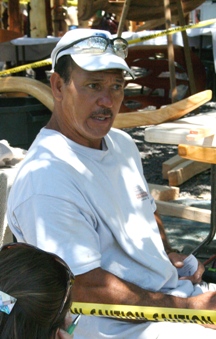
photo credit: Kahikina de Silva
Master carver Freddy Tauotaha has had a passion for canoes since childhood when he apprenticed under his father, Puaniho Tauotaha.
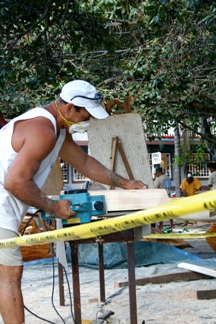
photo credit: Kahikina de Silva
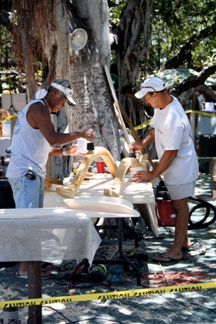
photo credit: Kahikina de Silva
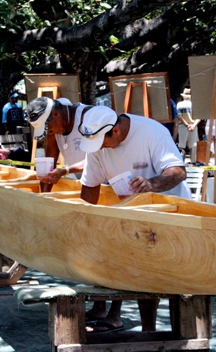
photo credit: Kahikina de Silva
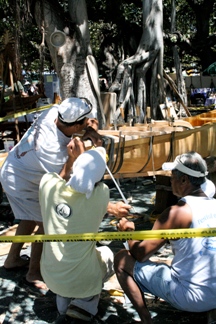
photo credit: Kahikina de Silva
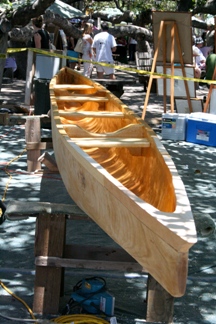
photo credit: Kahikina de Silva
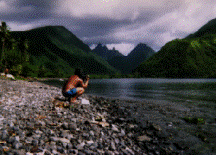
photo credit: Polynesian Voyaging Society
Sol Kaho‘ohalahala videotaping the bay and valley of Tautira in 1992.